Bumpy succulents – These wrinkly plants are not inherently weird. If you don’t believe me, take a look at this list of bumpy succulents found in nature. But when plant breeders start crossing succulents with other succulents to create these adorable ‘bumpy’ plants it is truly amazing. So, if you wish to learn about them, it would be worthwhile going through this article as I am going to discuss in detail some of the commonly spotted bumpy succulents.
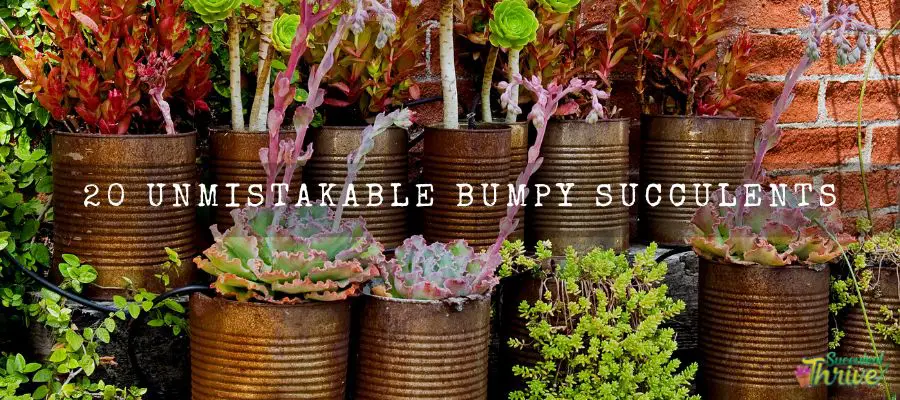
Adromischus marianiae ‘Herrei’
Adromischus marianiae ‘Herrei’ are small succulents that form in shrubs. They would develop branches that are slender and short. In terms of size, they would attain a maximum height of 4 inches (10cm). The leaves of the Adromischus marianiae ‘Herrei’ would tend to take a reddish-brown color or purple as they mature, they would become gray in color and waxy too. Besides, they may be irregularly warty too. The upper part of the plants would be grieved as well.
In addition to that, Adromischus marianiae ‘Herrei’ would emerge with flowers in green. They may also form tones in pink as well. The Adromischus marianiae ‘Herrei’ flower blossoms would be 0.5 inches ( 1.2cm) in length. The preferred hardiness zones of the Adromischus marianiae ‘Herrei’ would be 10a-11b from 30 degrees Fahrenheit (-1.1 degrees Celsius ) to 50 degrees Fahrenheit ( 10 degrees Celsius).

Aloinopsis spathulate
Aloinopsis spathulate are charming mat-forming succulents. heir leaves would be prominent in blue-gray colors. Further, the leaves would be round in shape and carry warts as well. These plants would reach a maximum height of one inch. Further, they would be 4-5 inches in width as well. You could expect them to produce flowers in bright pink during late winter to early spring. Aloinopsis spathulate would grow vigorously in the. USDA hardiness zones 5b to 9b: from −15 °F (−26.1 °C) to 30 °F (−1.1 °C).
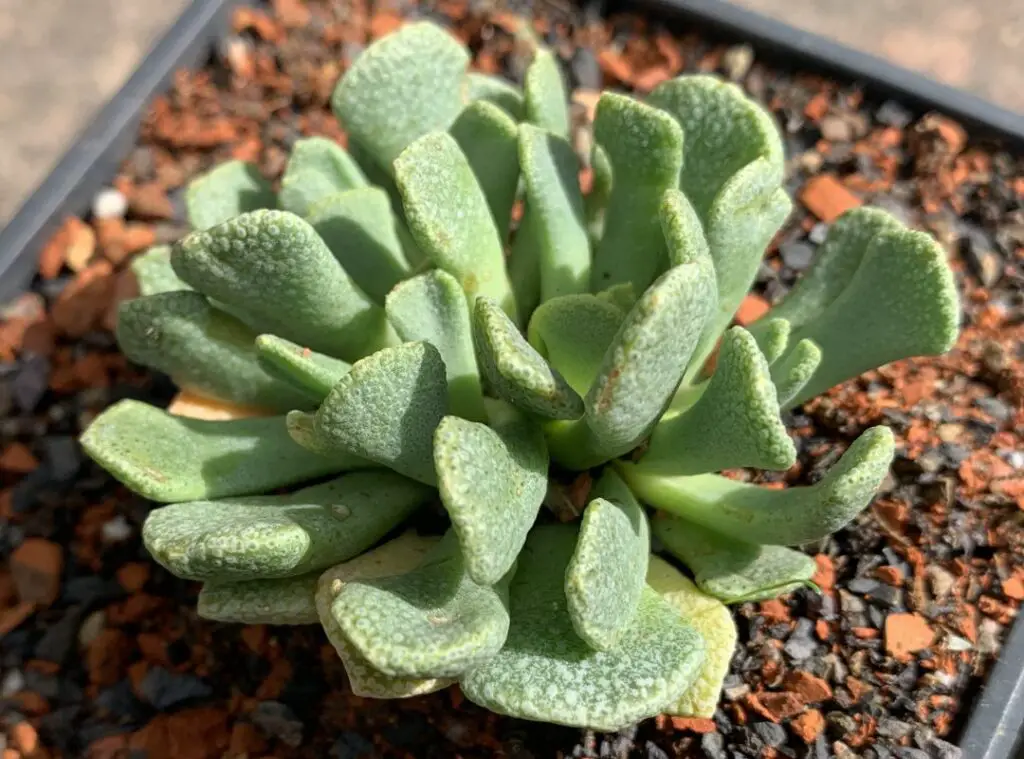
Crassula ausensis
Crassula ausensis is yet another attractive small set of succulents. Their leaves would form in clusters and make rosettes. Further, you could spot the Crassula ausensis leaves covered with pink, turquoise, and brown markings as well. Crassula ausensis stems would be short and may be carrying branches as well.
You could barely spot them from above the ground level. In addition to that, Crassula ausensis may blossom with flowers in white. Those flowers would be small, and they would usually come up in late fall to early winter. They would opt to grow well in USDA hardiness zones 9b-11b from 25 degrees Fahrenheit ( -3.9 degrees Celsius) to 50 degrees Fahrenheit (10 degrees Celsius).
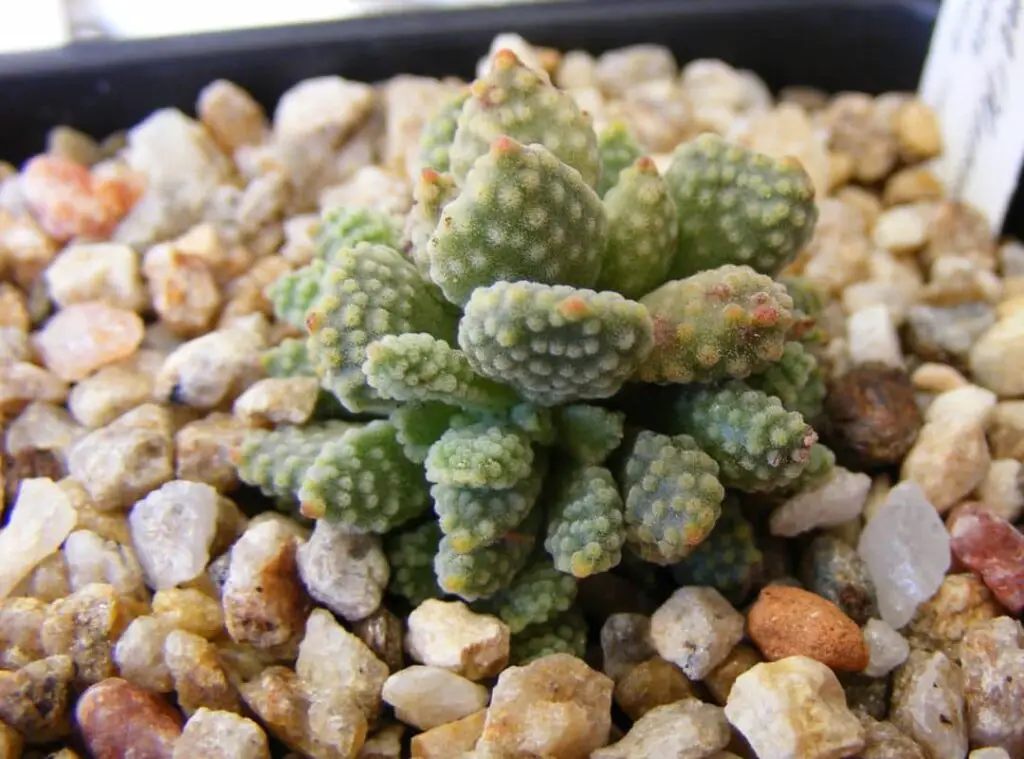
Echeveria gibbiflora var. Carunculata
Echeveria gibbiflora var. Carunculata plants come up with bumpy wart-like lumps. Those lumps are called carunculations. Those carunculations would usually develop on the upper surface of the leaves. They would attain a height of 1 foot ( 30cm). Furthermore, they would reach a maximum height of about 1 inch ( 2.5cm) broad at maturity and may also come up flush in red. The leaves would be about 8 inches ( 20cm) in length. The preferred USDA hardiness zones of the Echeveria gibbiflora var. Carunculata would be 9b to 11b from 25 degrees Fahrenheit ( -3.9 degrees Celsius) to 50 degrees Fahrenheit (10 degrees Celsius).
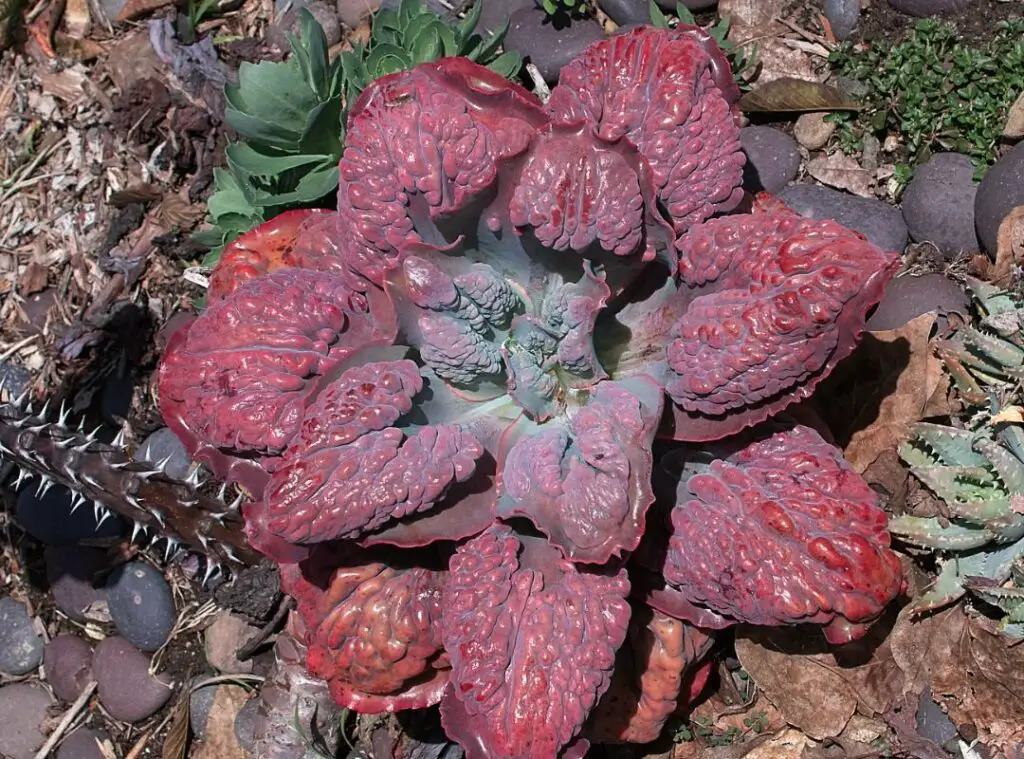
Echeveria ‘bumps’
Echeveria ‘bumps’ are yet another short-stemmed set of plants. They would comprise bumpy leaves which would add so much glamor to the whole look of the Echeveria ‘bumps’ plants. The leaves of the Echeveria ‘bumps’ would tend to take the shape of a spoon. Not only that but also, those leaves’ edges would be somewhat wavy too. Those leaves would form in a wide array of colors. For example, you could spot them coming up in silver, red, etc. It totally depends on the seasons.
If I further explain the Echeveria ‘bumps’ rosettes, they would be about 12 inches ( 30cm) broad. Echeveria ‘bumps’ plants may bear flowers of a reddish color. Further, those blooms would tend to take the shape of a bell. Those flowers would form on long stems during summer. Echeveria ‘bumps’ would grow hardy in USDA hardiness zones 10 a 11b from 30 degrees Fahrenheit ( -1.1 degrees Celsius) to 50 degrees Fahrenheit ( 10 degrees Celsius).
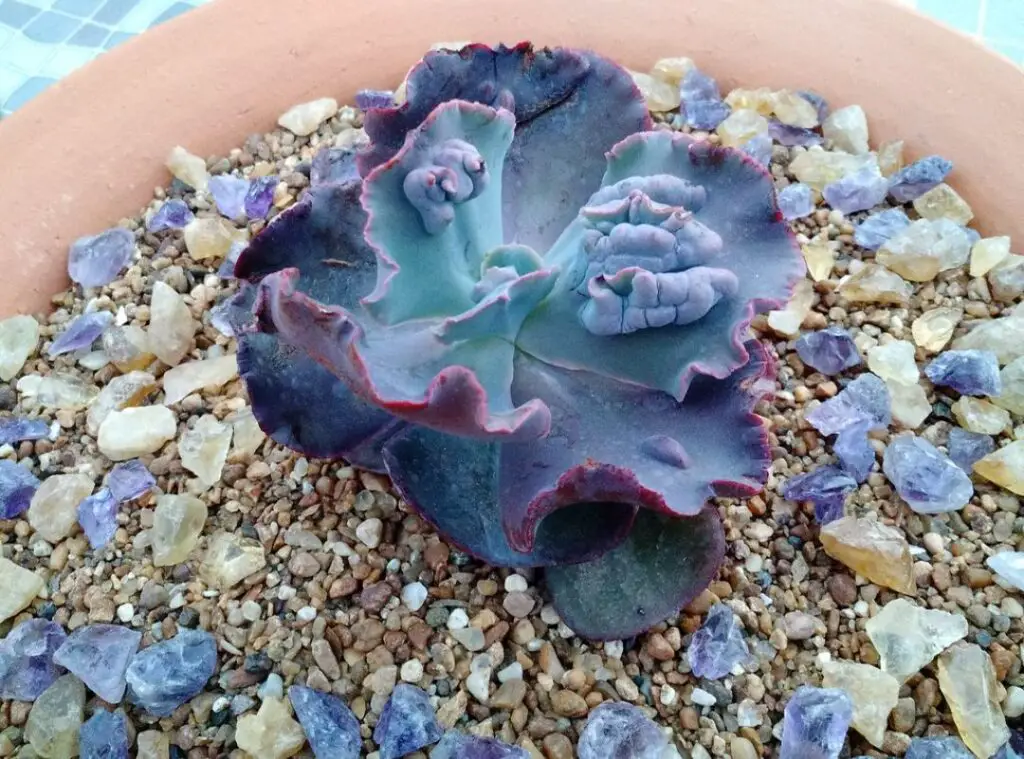
Echeveria Baron Bold
Echeveria Baron Bold which is called Baron Bold would attain a maximum height of 25 cm ( 10 inches ) in diameter. Echeveria Baron Bold would require a significant care treatment from you, and it is not a plant for freshers in gardening. Depending on the season you could spot them carrying red, green, or even silver-colored leaves. Echeveria Baron Bold would form only solitary rosettes and they would be about 10 inches ( 25 cm) at maturity. The preferred hardiness zones of the Echeveria Baron Bold would be 9b-11b from 25 degrees ( -3.9 degrees Celsius) to 50 degrees Fahrenheit ( 10 degrees Celsius).
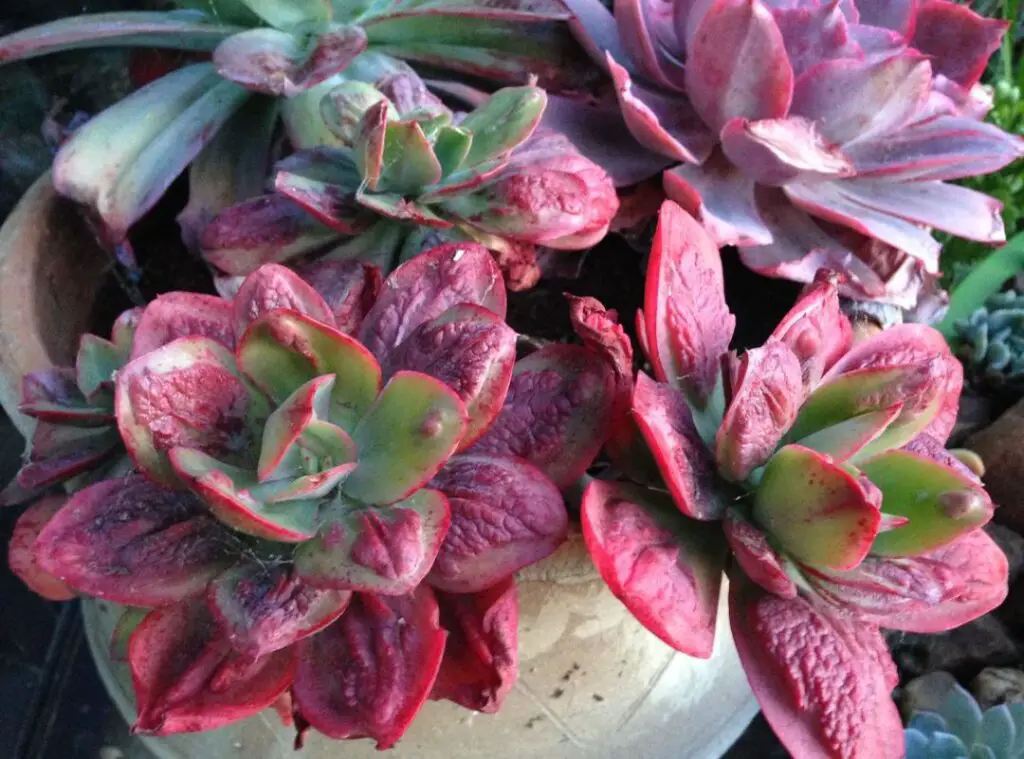
Echeveria Mauna Loa
Echeveria Mauna Loa are such adorable plants that form in rosettes. They would carry large flat leaves which would tend to take a crinkled shape at the edges of the leaves. The rosettes of the Echeveria Mauna Loa would be about 12 inches (30 cm) broad at maturity. Besides you can spot the Echeveria Mauna Loa leaves in pale green when they are young and immature.
However, as they grow, they would come up with blue and pink shades. Once you expose them to ample sunlight, they tend to turn the leaves’ edges reddish or burgundy in color. Echeveria Mauna Loa plants would grow firmly in USDA zones 9b-11b from 25 degrees Fahrenheit ( -3.9 degrees Celsius) to 50 degrees Fahrenheit ( 10 degrees Celsius).
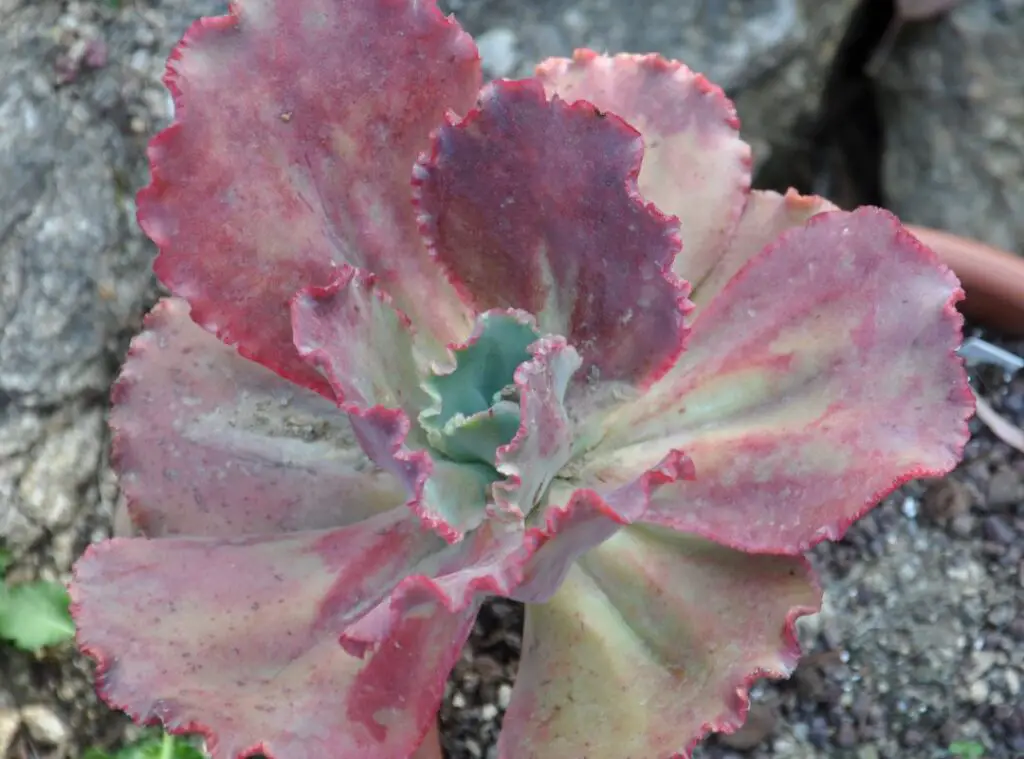
Echeveria ‘Lilac Frost’
Echeveria ‘Lilac Frost plants produce giant rosettes. They also come up with a bumpy texture all over their leaf surface as they grow older. They can in fact become 12 inches in height. They have a unique color that is distinctive to them, and it would be mint green in color. However, this color would also change depending on the season and chances are that they may take a lavender color. Echeveria ‘Lilac Frost leaves would come up with a powdery coating farina layer. They would grow vigorously in USDA hardiness zone 10 ( 30 degrees Fahrenheit). You could witness Echeveria ‘Lilac Frost’ plants bearing flowers in pink.
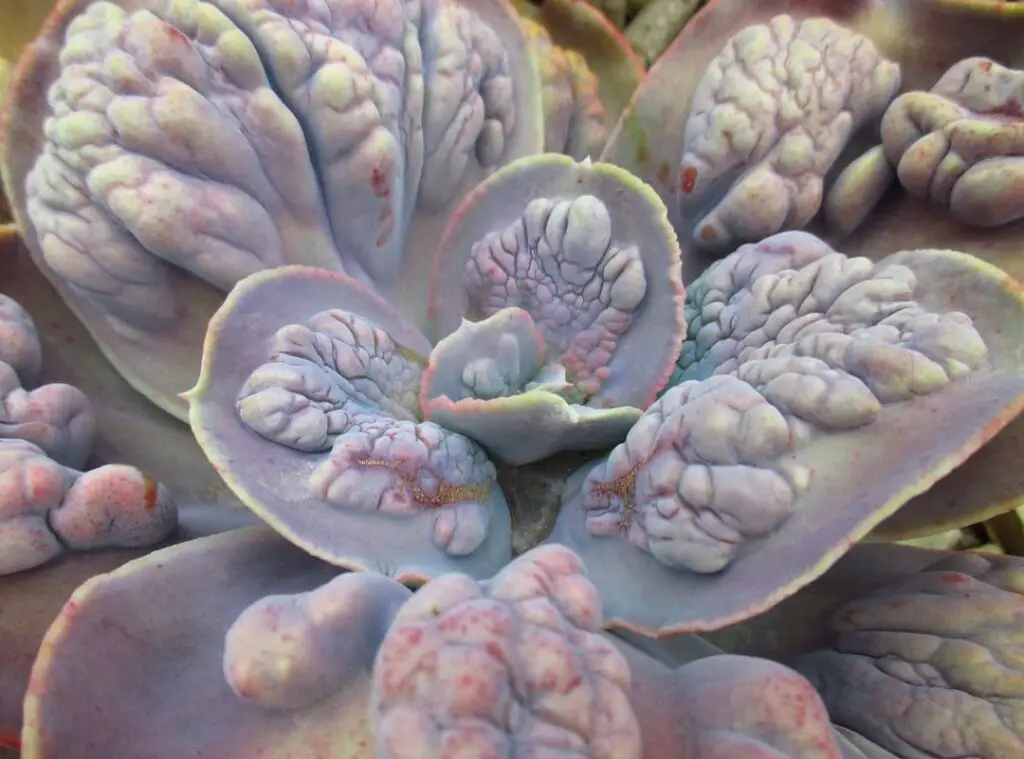
Echeveria Raindrop
Echeveria Raindrops are some attractive-looking sets of plants that would attain a maximum width of around 15 cm ( 6 inches ) when they are mature. The Echeveria Raindrop leaves would be quite prominent in green. Further their edges would be red in color too. The leaves would tend to take a spherical shape. The bumpy looks of the larger parts of the leaves are what make them plants look more glamorous and popular among succulent enthusiasts.
You could spot the bump in blue-green colors mainly. The bump would tend to take the shape of a water droplet. However, you cannot spot this feature in the young plants though. Echeveria Raindrop prefers to grow in the conditions they get in USDA hardiness zones 9b- 11b from 25 degrees Fahrenheit ( -3.9 degrees Celsius) to 50 degrees Fahrenheit ( 10 degrees Celsius).
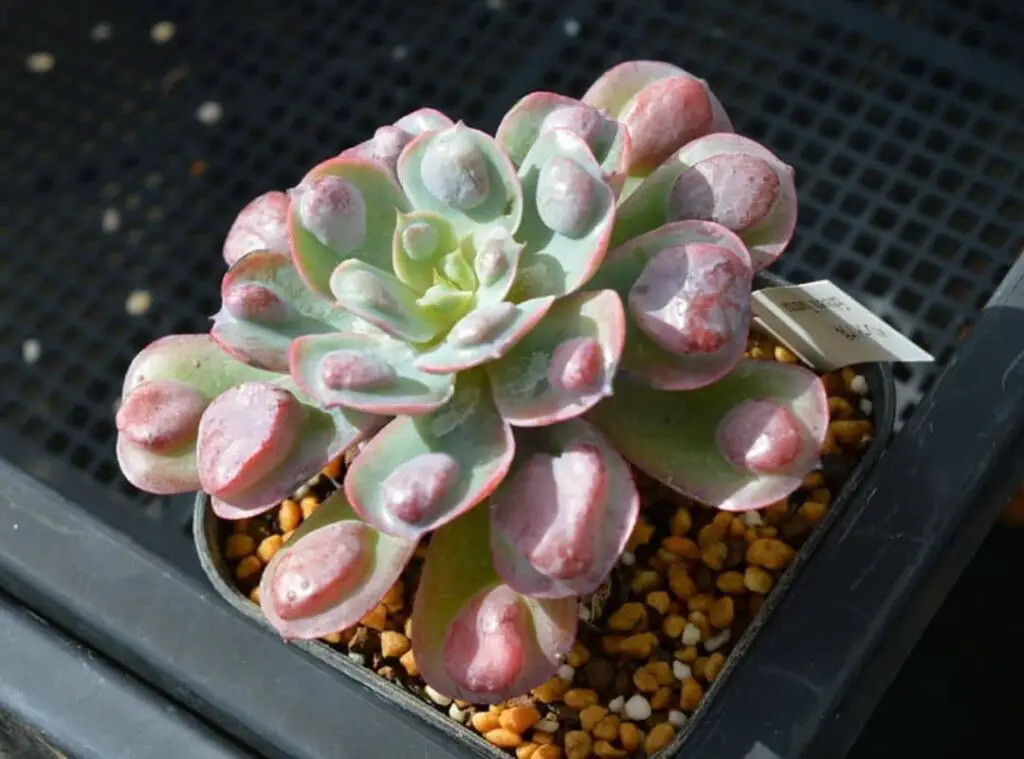
Echeveria ‘Culibra bumpy’
Echeveria ‘Culibra bumpy’ plant is a creation of Dick Wright. They would feature 7-inch rosettes which would consist of blue leaves. Further, they may also carry pink margins as well. The Echeveria ‘Culibra bumpy’ leaves would be narrow and tend to take an elongated shape. Further, those leaves may be topped with a bumpy caruncle too. The bumpy caruncle would make the leaves’ margins curl down and give a wavy shape to the plants. Echeveria ‘Culibra bumpy’ plants grow in a compact manner. Further, they don’t have a frost tolerance and are hardly below USDA zone 9.
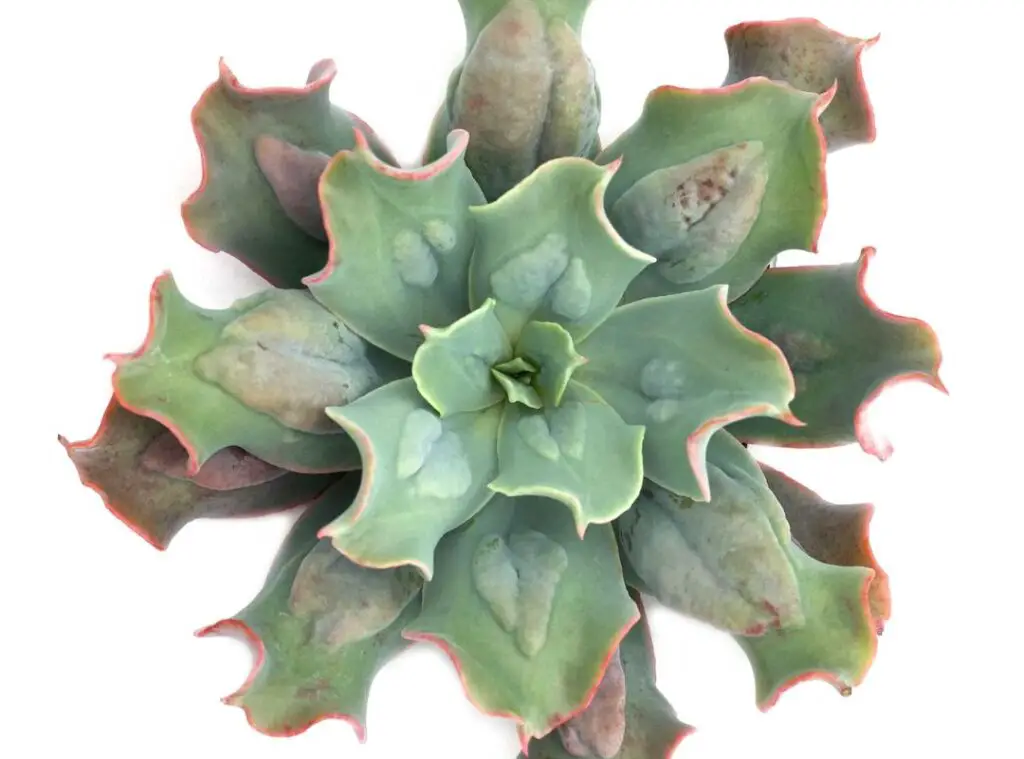
Echeveria Verrugas
Echeveria Verrugas plants are yet another hybrid creation of Dick Wright and this is one of the most famous bumpy Echeverias out of all the Echeveria varieties. They would not showcase any sign of lumps or any bumps when they are young. However, as they grow older, you could spot them developing more lumps as well as bumps. Further, they would tend to change their shape as they grow too. Once the plants are getting ready to bloom, their leaves would tend to curl down. Further, their color of soft blue would turn into bright pink and purple flushes as well. In addition to these features, Echeveria Verrugas plants may emerge with blooms during mid-autumn.
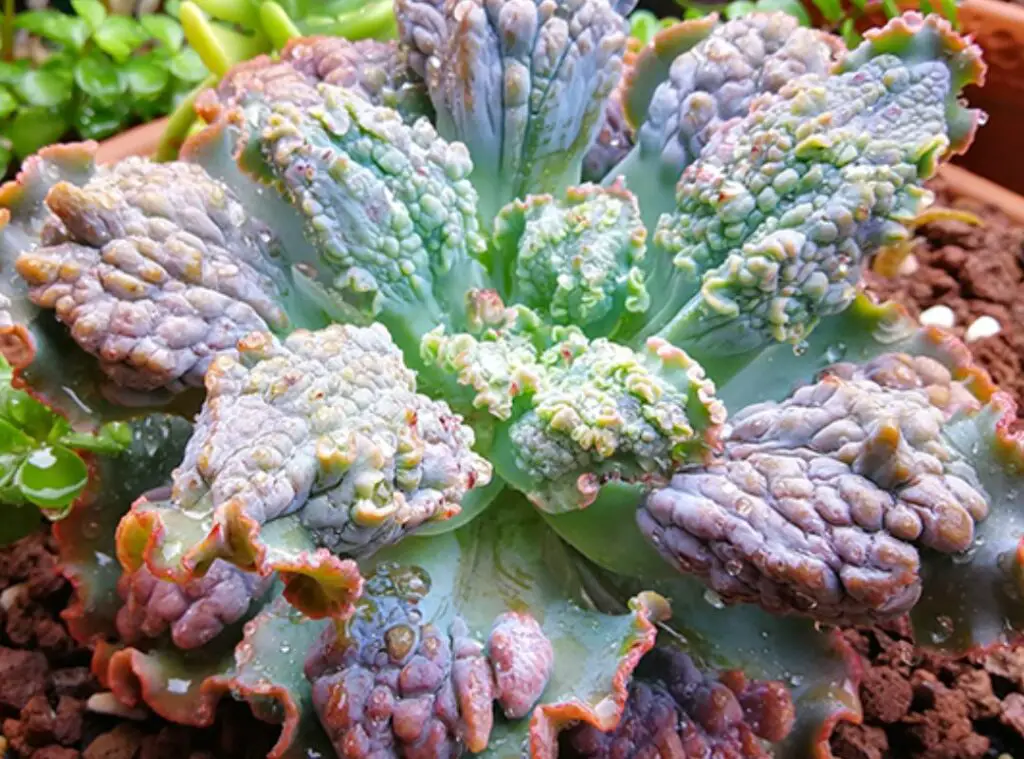
Echeveria Etna
Echeveria Etna is quite popular for its odd looks. One might think that their leaves are damaged too. Echeveria Etna leaves are large and tend to take a waxy look. Those leaves would be quite prominent in blue-purple. You could spot their leaves folding down during summer and that would give a spear shape to the plants. During winter Echeveria Etna leaves would tend to take a flattened shape as that would allow them to gain more sunlight.
In terms of the sizes of the Echeveria Etna plants, they would grow as tall as12 inches ( 30.5cm ). Further, they would be 12 inches ( 30.5cm) broad as well. Echeveria Etna optimal growing conditions would be in Zone 10a. Last but not least Echeveria Etna would bear flowers in orange-red colors. Those flowers would be bell-shaped. Furthermore, those flowers would arise on a long inflorescence.
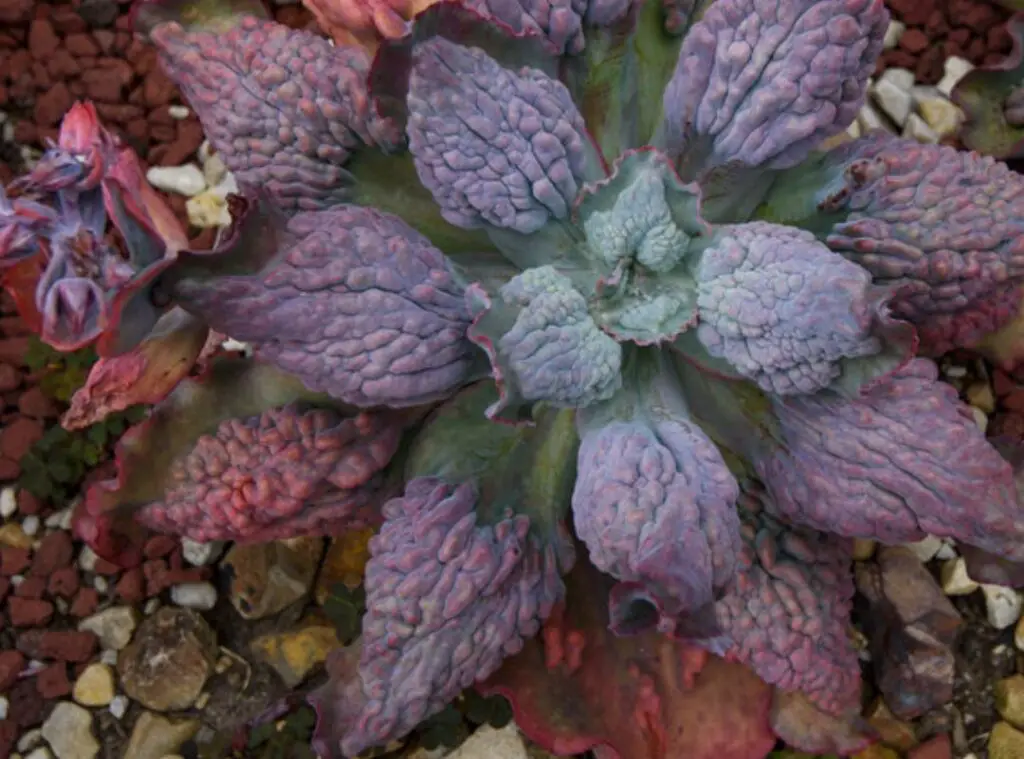
Echeveria ‘Paul Bunyan’
Echeveria ‘Paul Bunyan’ plants some stunning-looking sets of succulents. Their colors would intensify as the sunlight exposure enhances. In fact, you could spot them showing a purple and a blue color as the sunlight exposure increases. Echeveria ‘Paul Bunyan’ plants would also develop a bumpy leaf surface which is the highlight of these plants. The Echeveria ‘Paul Bunyan’ leaves would form a ball-shaped rosette at the end. They would tend to show a compact growth pattern. Echeveria’s’ Paul Bunyan’ plants preferred USDA Zone are 10a: -1.1 °C (30 °F).to USDA Zone 10b: to 1.7 °C (35 °F).
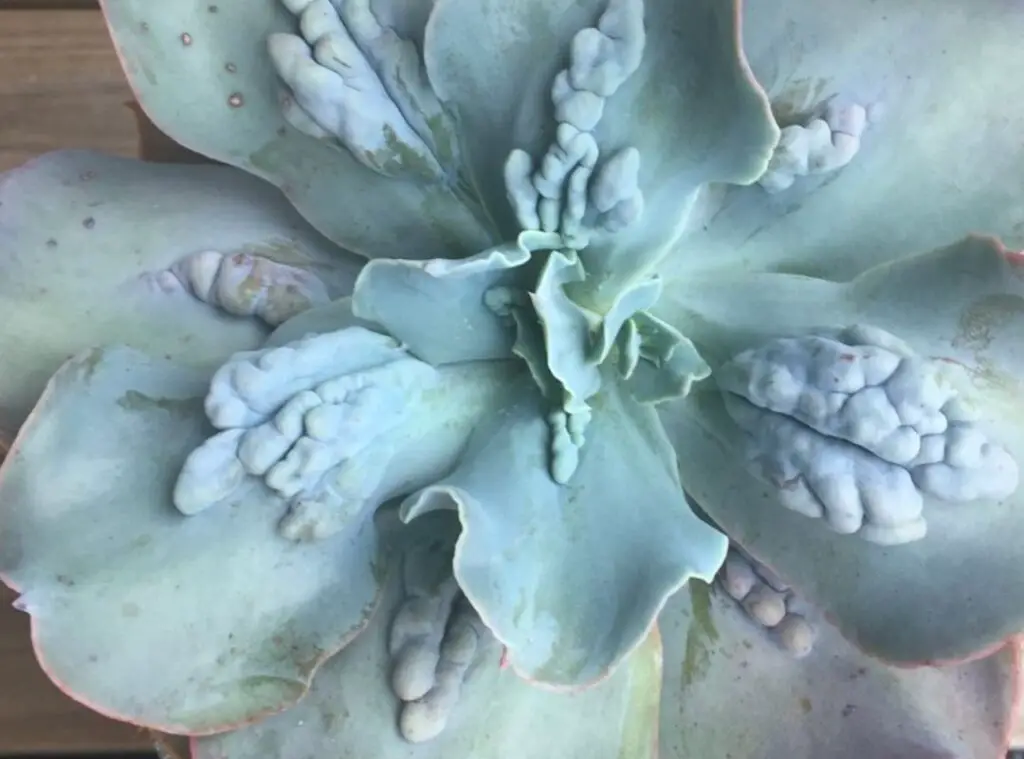
Echeveria Sea Dragon
Echeveria Sea Dragon is a spectacular plant that would produce a short stem. They would also develop a rosette which would consist of gray-green to reddish-colored leaves. In fact, you could spot them arising in a wide array of colors. Echeveria Sea Dragon rosettes would be about 12 inches ( 30 cm) in height when they are fully mature. Further diameter wise they would be about 16 inches ( 40cm).
Echeveria Sea Dragon leaves would tend to look like a spoon. Echeveria Sea Dragon leaves would also carry wavy edges too. Moreover, you may expect them to produce flowers in reddish-yellow colors. Besides those flowers would tend to take a bell shape as well. The preferred USDA zones of the Echeveria Sea Dragon would be 9a-10b from 20 degrees Fahrenheit to 40 degrees Fahrenheit.
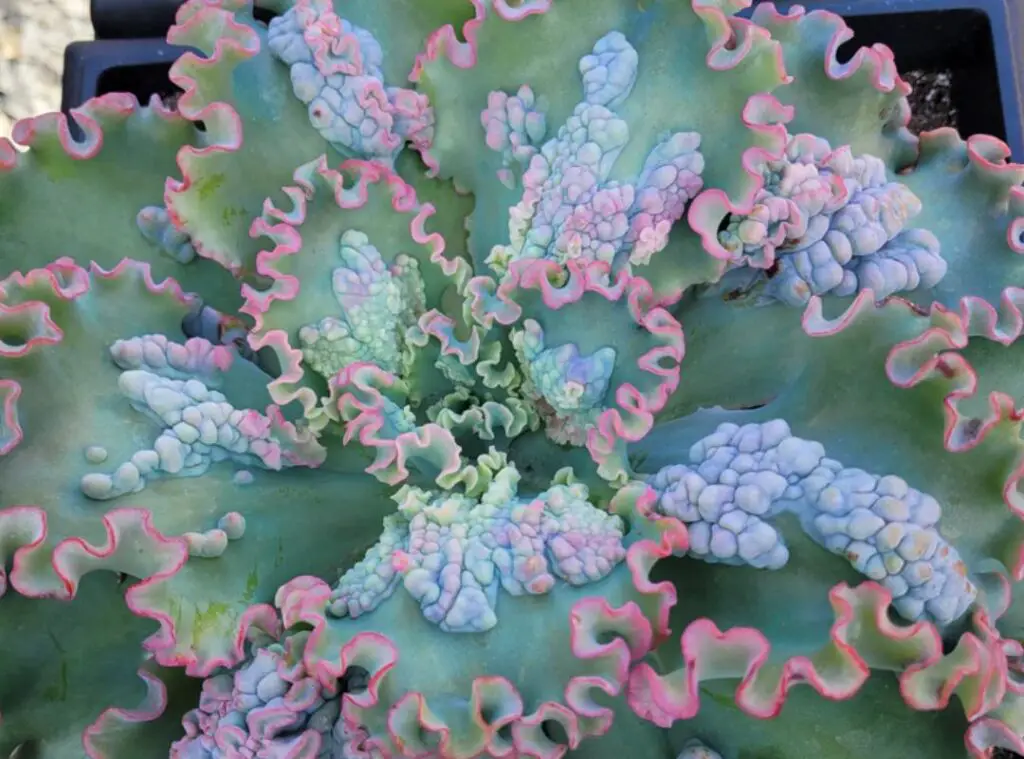
Echeveria ‘Virginia Lee’
Echeveria ‘Virginia Lee’ are some magnificent looking succulents that would come up with short stems. Furthermore, Echeveria ‘Virginia Lee’ leaves would develop rosettes in red to purple colors. Those leaves would be covered with warts or caruncles too. Echeveria ‘Virginia Lee’ leaves tips would be somewhat curled just like most of the aforesaid plants.
Echeveria ‘Virginia Lee’ rosettes would attain a maximum height of 12 inches ( 30 cm) when they grow to their best potential. Further, they would be about 16 inches ( 40cm) broad at maturity. Echeveria ‘Virginia Lee’ leaves would be about 8 inches ( 20cm) in length. The conditions in USDA zones 9b-11b range from 25 degrees Fahrenheit ( -3.9 degrees Celsius) to 50 degrees Fahrenheit ( 10 degrees Celsius).
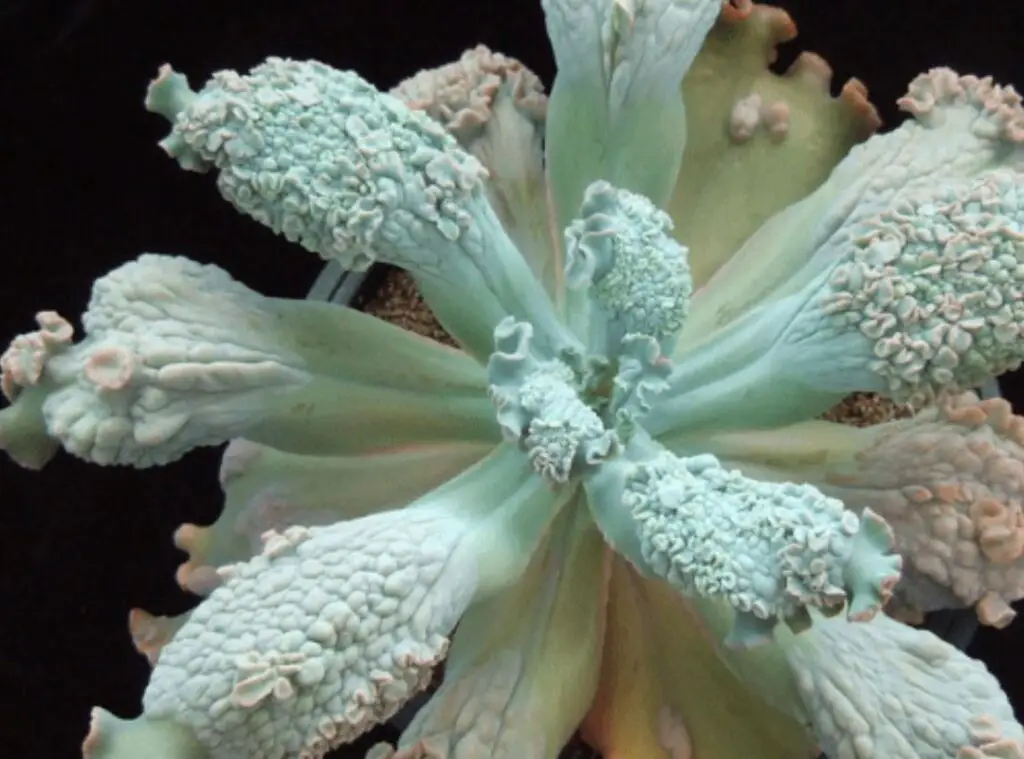
Faucaria tuberculosa
Faucaria tuberculosa are clump-forming sets of plants that would achieve a maximum height of 6 inches ( 15cm) at maturity. Furthermore, the leaves of the Faucaria tuberculosa would be dark green in color and they may also consist of whitish dots and patches as well. In addition to that, you could spot some soft white structures which would tend to look like teeth. The Faucaria tuberculosa leaves would be more like ovata triangular in shape.
Moreover, the leaves would be 1 inch ( 2.5cm) in length. Besides they would be 0.8 inches ( 2cm) broad too. Those leaves would form in opposite pairs. In addition to these features, Faucaria tuberculosa may develop flowers in yellow and they would tend to take a daisy look. The conditions in USDA hardiness zones 9b-11b from 25 degrees Fahrenheit ( -3.9 degrees Celsius) to 50 degrees Fahrenheit (10 degrees Celsius).
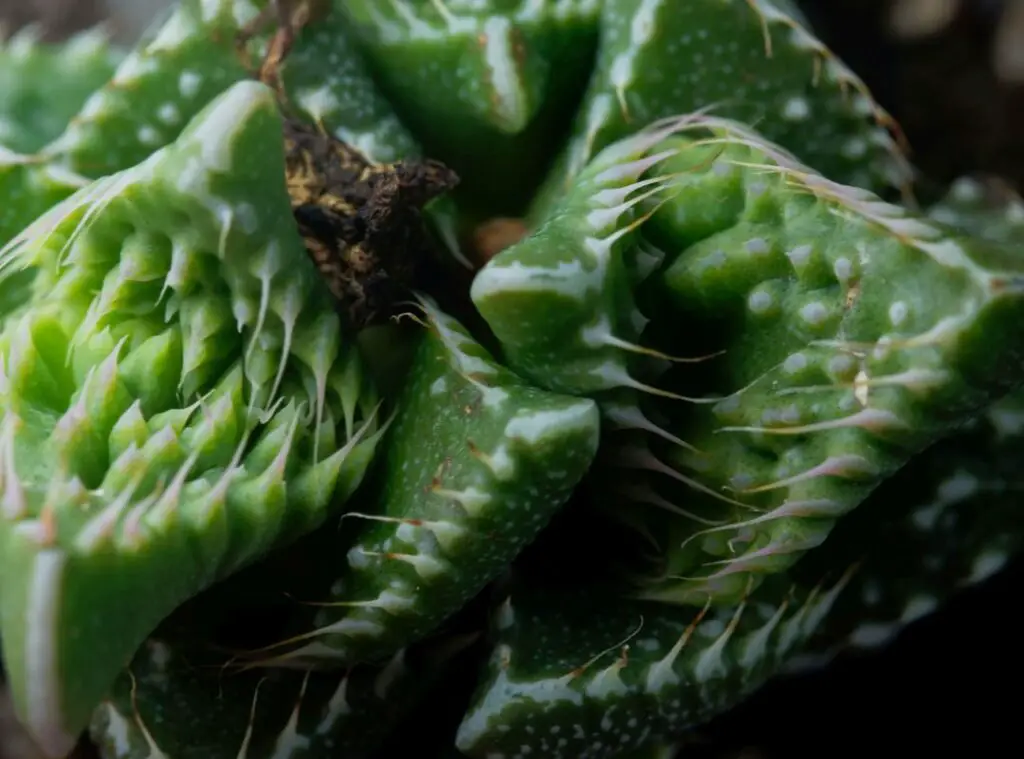
Haworthia pumila
Haworthia pumila are slow growers. Their leaves would be thick and fleshy. Moreover, They would tend to take an olive green to a dark brown color. Moreover, their leaves would be covered with white tubercles and form a rosette. The rosettes would attain a maximum height of 12 inches (30cm). Furthermore, they would be 6 inches (15cm) in diameter too. Leaves of the Haworthia pumila would be triangular or ovate in shape.
Moreover, the leaves would be 5.6 inches (14cm) in length. Besides, their width would be around 0.8 inches ( 2cm). Last but not least, Haworthia pumila plants would produce flowers in greenish to brownish-white colors. Those flowers would also carry a waxy texture. Further, they would arise on the slender flower spikes during summer. Haworthia pumila optimal growing conditions could be found in USDA zones 10a-11b ( 30 degrees to 50 degrees Fahrenheit ( -1.1 degrees Celsius – 10 degrees Celsius).
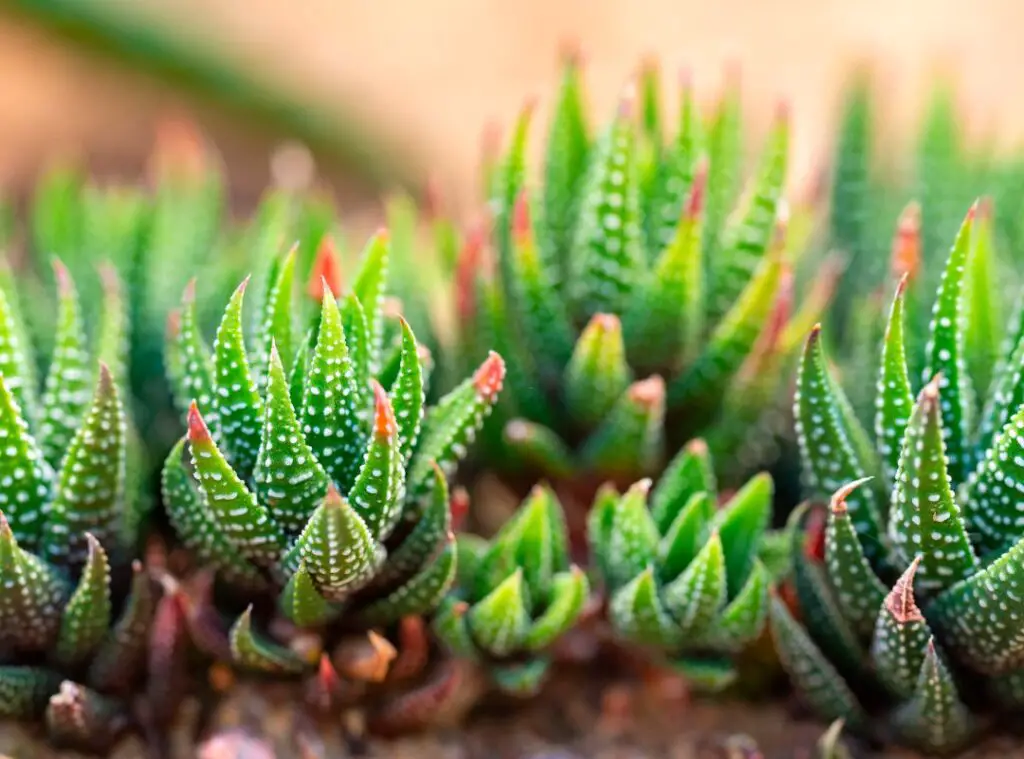
Haworthia tessellate
Haworthia tessellate grows without any stem usually. However, Haworthia tessellate are also rosette forming sets of plants and they would comprise fleshy firm leaves. You could spot those leaves in green to brown colors. They would attain a maximum height of 6 inches ( 15cm). Besides, they would be about 4 inches (10cm) wide at maturity. Haworthia tessellate leaves are more triangular-shaped.
Furthermore, they would be recurved up to 2 inches in length as well. The preferred hardiness zones of the Haworthia tessellate would be 9b-11b from 25 degrees Fahrenheit (-3.9 degrees Celsius ) to 50 degrees Fahrenheit (10 degrees Celsius). Lastly, Haworthia tessellate may emerge with large flowers which you could spot in white and green. The flowers tend to take a tubular shape.
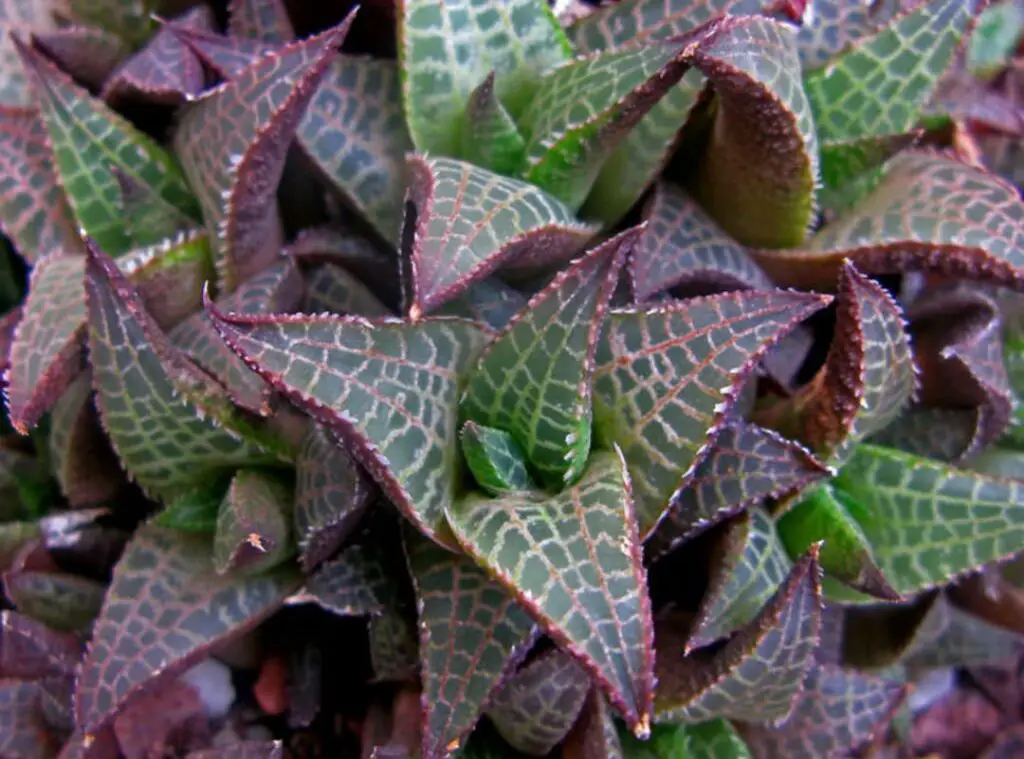
Titanopsis calcarea
Titanopsis calcarea is a mat-forming succulent. They would also form rosettes which would consist of gray or blue-green colored leaves. Besides you could witness the Titanopsis calcarea leaves come up with white, creamy gray colored tubercles as well. Titanopsis calcarea rosettes would be 3 inches ( 7.5cm) broad. The leaves of the Titanopsis calcarea would be thick just like the rest of other fellow succulents. They would come up with some attractive flowers in yellow to orange. Moreover, Titanopsis calcarea would opt to grow in USDA hardiness zones 9a-11b from 20 degrees Fahrenheit (-6.7 degrees Celsius ) to 50 degrees Fahrenheit ( 10 degrees Celsius).
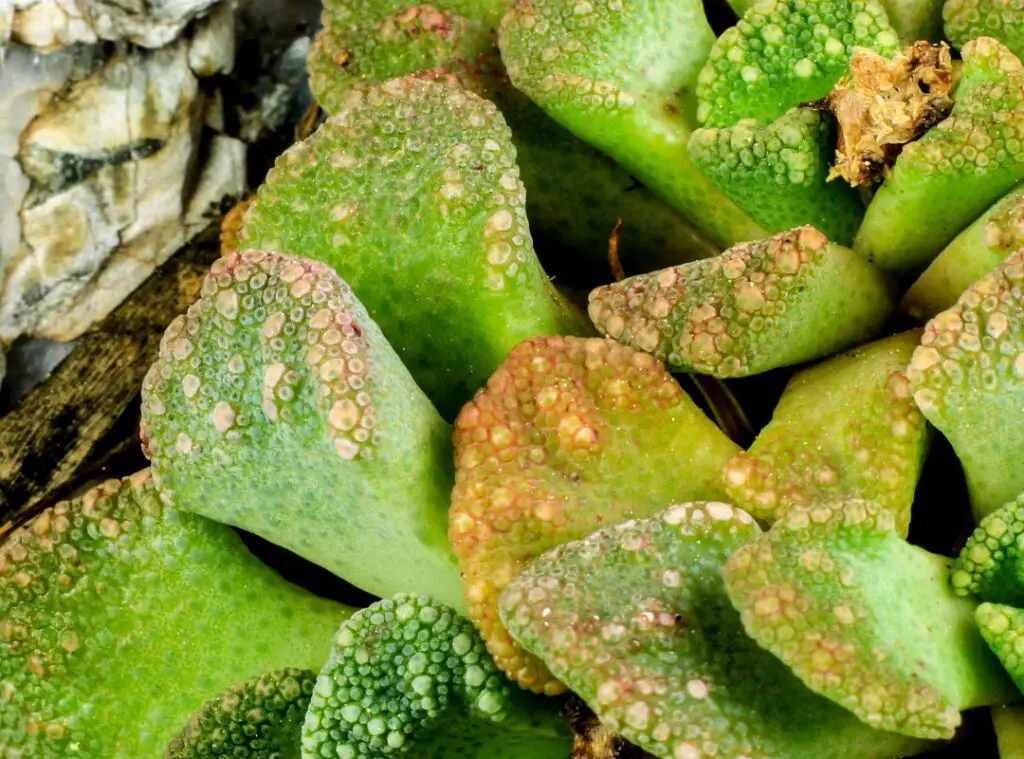
Zebra Cactus (Haworthia)
Zebra cactus is yet another unique-looking succulent that come up with thick leaves. Those leaves would be prominent in dark green colors. Besides they would come up with horizontally made stripes outside of the leaf’s surface. Having said that, the inside of the leaves would be smooth. When it comes to the sizes of the plants, they would grow up to 5 inches (13 cm) in height. Furthermore, they would be about 8 inches ( 20 cm) broad as well. The ideal conditions for the vigorous growth of the Zebra cactus could be found in Zone 10 (Minimum 30° F | -1.1° C).
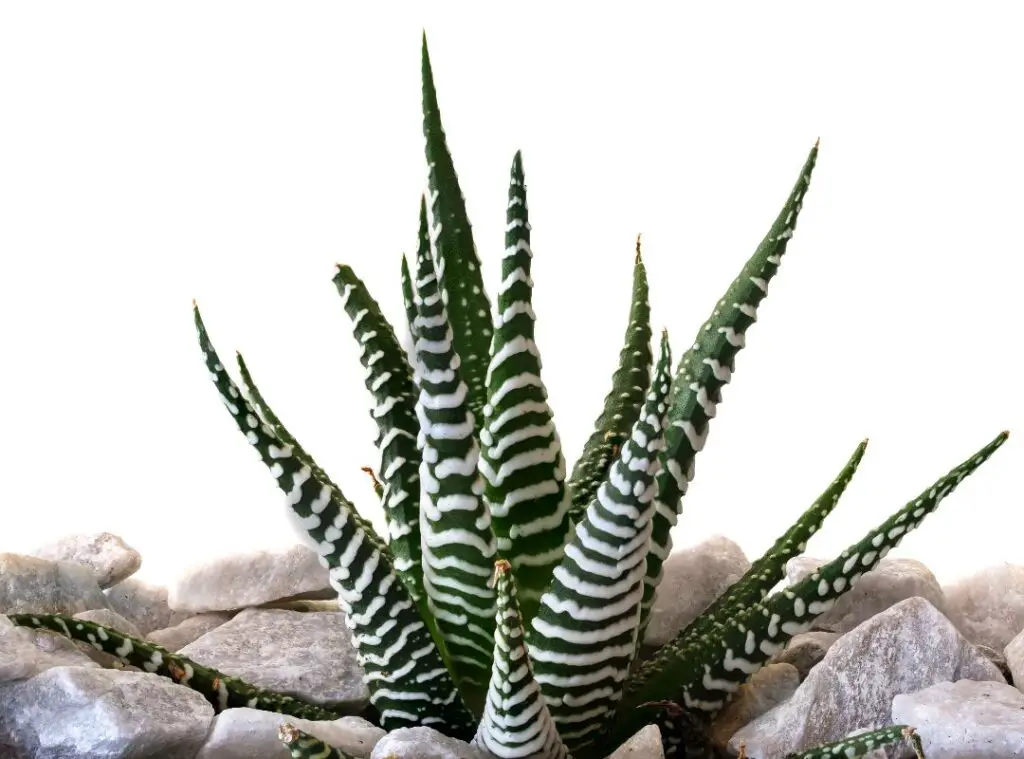
Variegated Gasteraloe
Variegated Gasteraloe is a hybrid of Gasteria and Aloe plants. They would usually develop leaves in yellow or in green. Besides, the leaves would be thick and smooth as well. These are slow-growing sets of plants that would grow up to 30 cm in diameter at maturity.
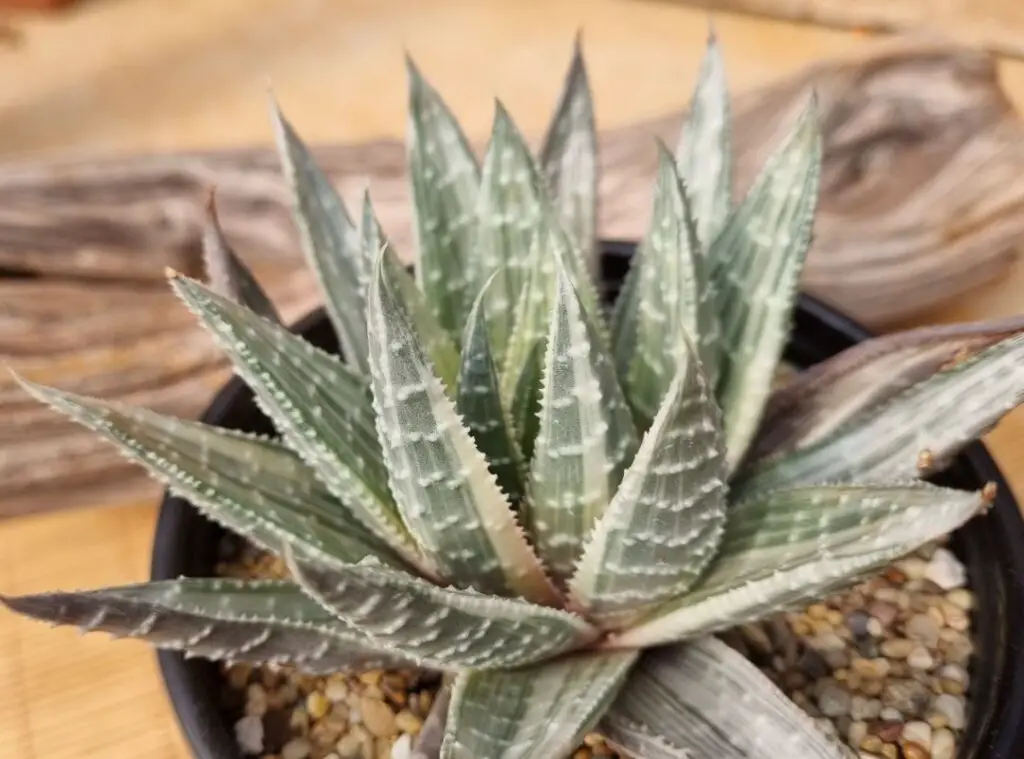
Bumpy succulents: is it a disease?
If you ever come across any bumpy leaves on succulents and wonder what it is, it is more like a condition that takes place due to an imbalance of transpiration and water storage system of the succulents. I am not talking about little bumps in succulent leaves as we talk above. In this condition whole succulent leaf bump up. Once this happens, your succulents may build up the excess water in the leaves and it would put pressure on the plant. That would eventually make the plant’s cells stretch and collapse. Ultimately it would contribute to irregular bumps and blisters of the succulents. To overcome this problem you should not overwater the succulent. Maintain a proper watering schedule and use well-draining soil to plant your succulents.
Read Next : How To Choose Best Succulents To Pair Together (And Care Tips)
